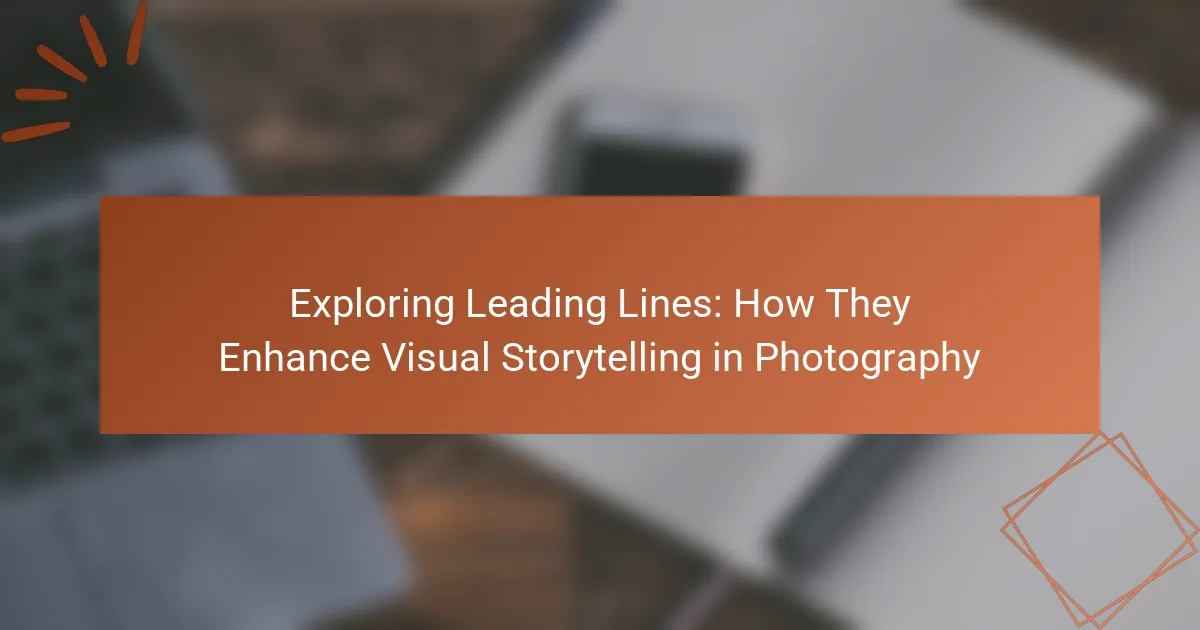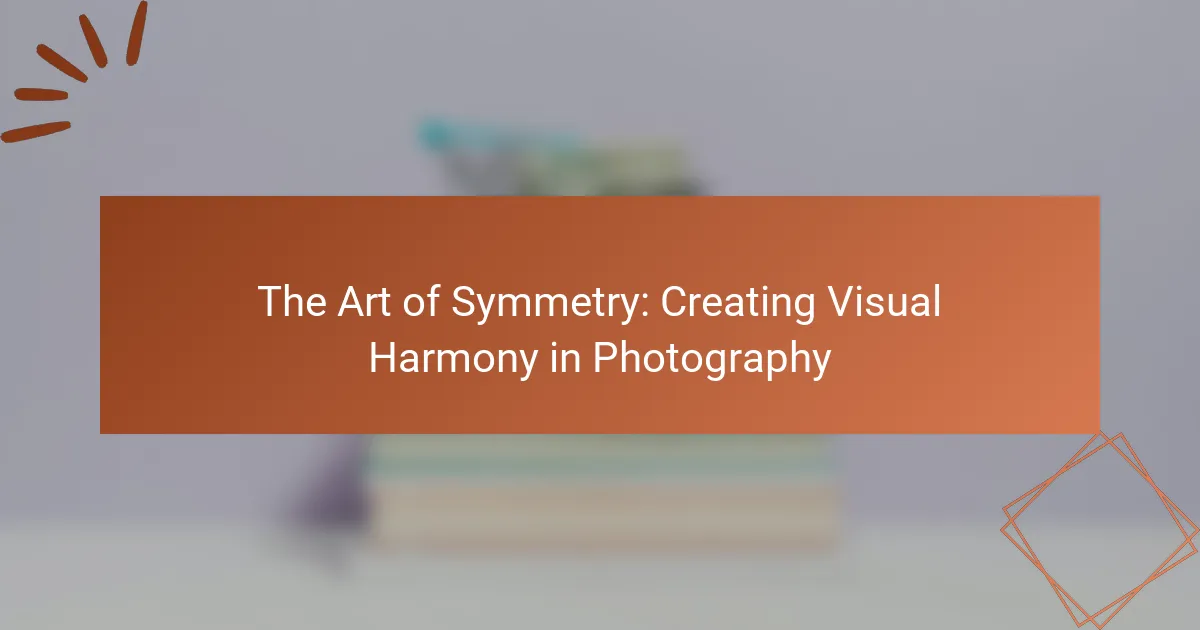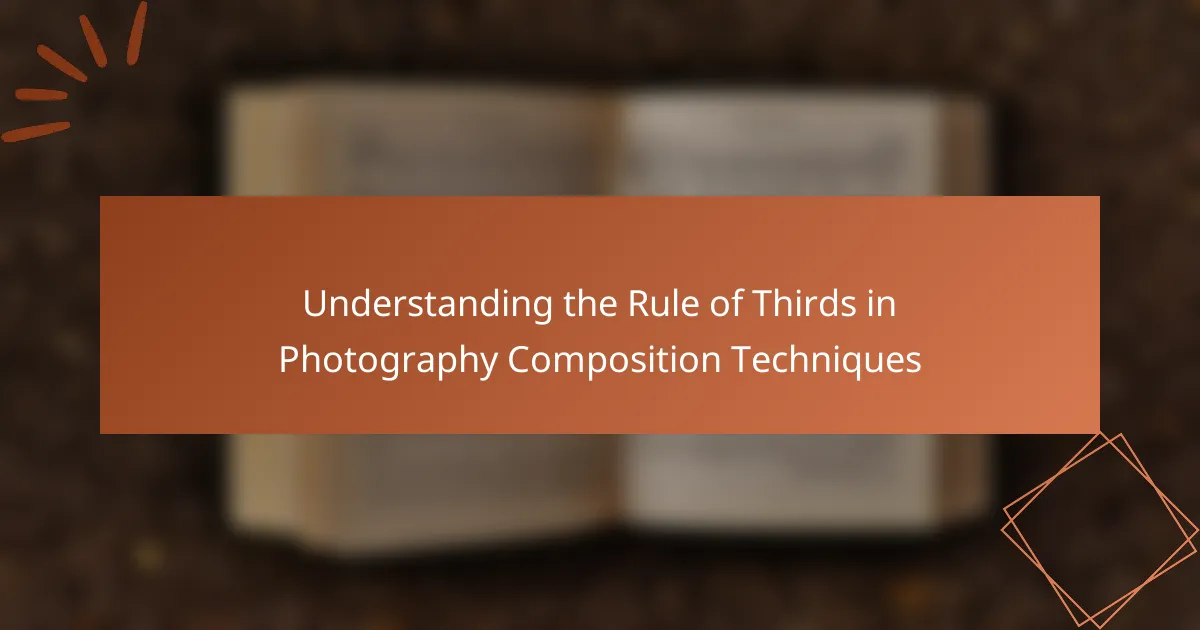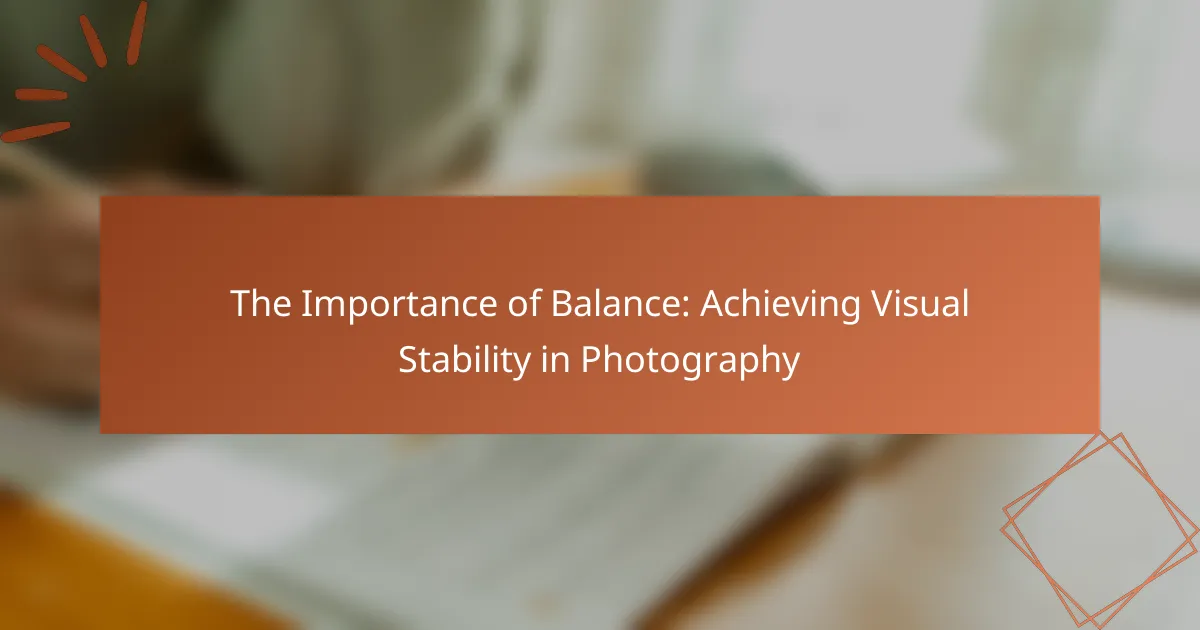Perspective in composition refers to the viewpoint from which a subject is observed, significantly influencing the emotional tone and narrative depth of a piece. This article explores how different perspectives, such as first-person and third-person, affect audience engagement and interpretation of the subject matter. Key elements of perspective, including depth, angle, and focal point, are examined for their roles in enhancing visual storytelling. Techniques for effectively applying perspective, such as utilizing varying angles and incorporating foreground and background elements, are also discussed. Historical examples and literature illustrate how shifts in perspective can reveal character motivations and themes, underscoring the importance of perspective in conveying meaning and impact.
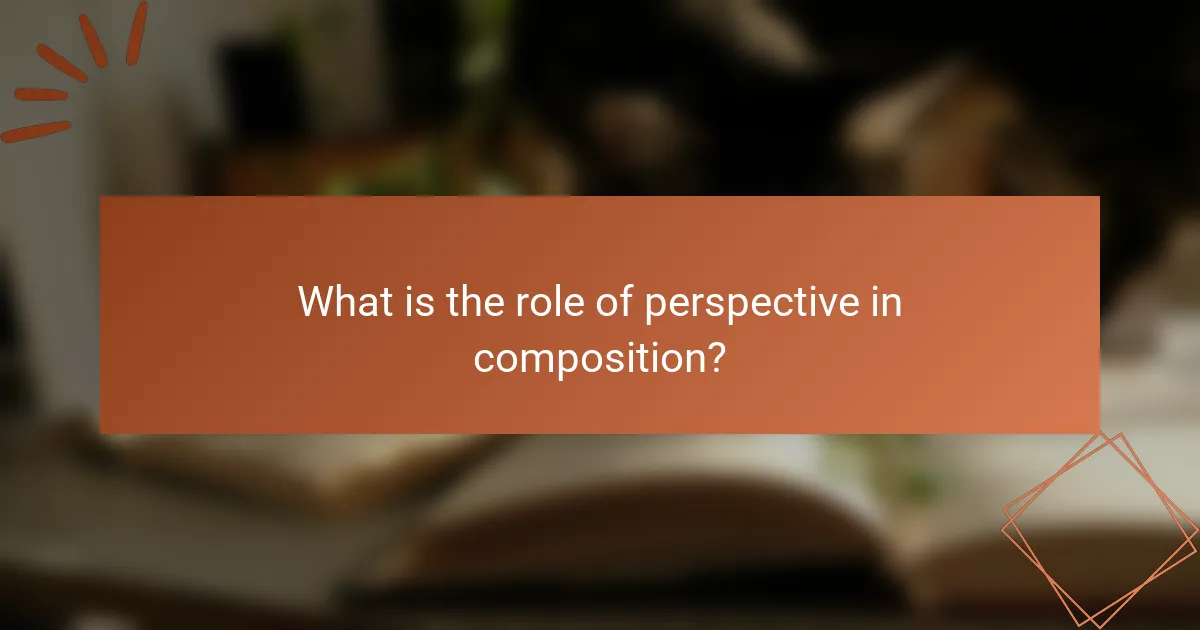
What is the role of perspective in composition?
Perspective in composition determines how a subject is viewed and interpreted. It influences the emotional tone and narrative depth of a piece. Different perspectives can alter the viewer’s understanding of the subject. For example, a first-person perspective creates intimacy, while a third-person perspective offers objectivity. The choice of perspective shapes the audience’s engagement with the content. Historical examples show that perspective can change the interpretation of events. In literature, shifting perspectives can reveal character motivations and themes. Overall, perspective is crucial for conveying meaning and enhancing the composition’s impact.
How does perspective influence visual storytelling?
Perspective significantly influences visual storytelling by shaping how viewers interpret images. It determines the angle and distance from which a scene is portrayed. Different perspectives can evoke varying emotional responses. For example, a low-angle shot can make a subject appear powerful. Conversely, a high-angle shot may suggest vulnerability.
The choice of perspective also affects narrative focus. A close-up can highlight details and emotions, while a wide shot provides context. This manipulation of perspective guides the audience’s attention and understanding. Research shows that perspective can alter perceptions; a study by Tversky and Hard (2009) found that spatial perspective affects how information is processed.
Ultimately, perspective is a vital tool in visual storytelling, influencing both emotional engagement and narrative clarity.
What are the different types of perspectives used in composition?
The different types of perspectives used in composition include first-person, second-person, and third-person perspectives. First-person perspective uses “I” or “we,” allowing readers to experience the narrative through the narrator’s eyes. Second-person perspective addresses the reader directly with “you,” creating an immersive experience. Third-person perspective can be limited or omniscient, offering a broader view of the story. Limited third-person focuses on one character’s thoughts and feelings, while omniscient third-person knows all characters’ inner workings. These perspectives shape the reader’s understanding and emotional connection to the narrative.
How does perspective shape the viewer’s interpretation of a composition?
Perspective significantly influences how a viewer interprets a composition. It determines the angle and distance from which the composition is viewed. Different perspectives can evoke varied emotional responses. For example, a low-angle view can make subjects appear powerful. Conversely, a high-angle view can create a sense of vulnerability. The arrangement of elements within the frame also alters perception. Foreground and background relationships can guide the viewer’s focus. Research in visual perception shows that perspective affects cognitive processing of images. This indicates that viewers may derive different meanings based on their vantage point.
Why is understanding perspective essential for artists and photographers?
Understanding perspective is essential for artists and photographers because it influences how viewers perceive depth and space in their work. Perspective determines the relationship between objects in a composition. It allows artists to create a sense of realism or abstraction. Mastery of perspective can enhance storytelling within an image.
For example, linear perspective uses converging lines to create depth. Artists like Leonardo da Vinci utilized this technique in works such as “The Last Supper.” Photographers often apply perspective to direct viewer attention. Techniques like framing and angle selection can alter perception significantly. Understanding these principles is crucial for effective visual communication.
What skills can be developed by mastering perspective in composition?
Mastering perspective in composition develops skills such as spatial awareness, depth perception, and visual storytelling. Spatial awareness allows artists to understand the relationship between objects in a scene. Depth perception enhances the ability to create realistic three-dimensional space on a two-dimensional surface. Visual storytelling skills improve as artists learn to guide the viewer’s eye through a composition. Additionally, mastering perspective can enhance technical drawing skills and improve overall composition techniques. These skills are essential for creating compelling and engaging visual narratives.
How does perspective enhance the emotional impact of a composition?
Perspective enhances the emotional impact of a composition by influencing how viewers interpret the subject matter. Different angles can evoke distinct feelings and responses. For example, a low-angle shot can instill a sense of power or dominance. Conversely, a high-angle shot may convey vulnerability or insignificance. The choice of perspective can also guide the viewer’s focus and emotional engagement. Studies show that perspective shapes narrative understanding and emotional resonance in visual art. By manipulating perspective, artists can effectively communicate complex emotions and themes.
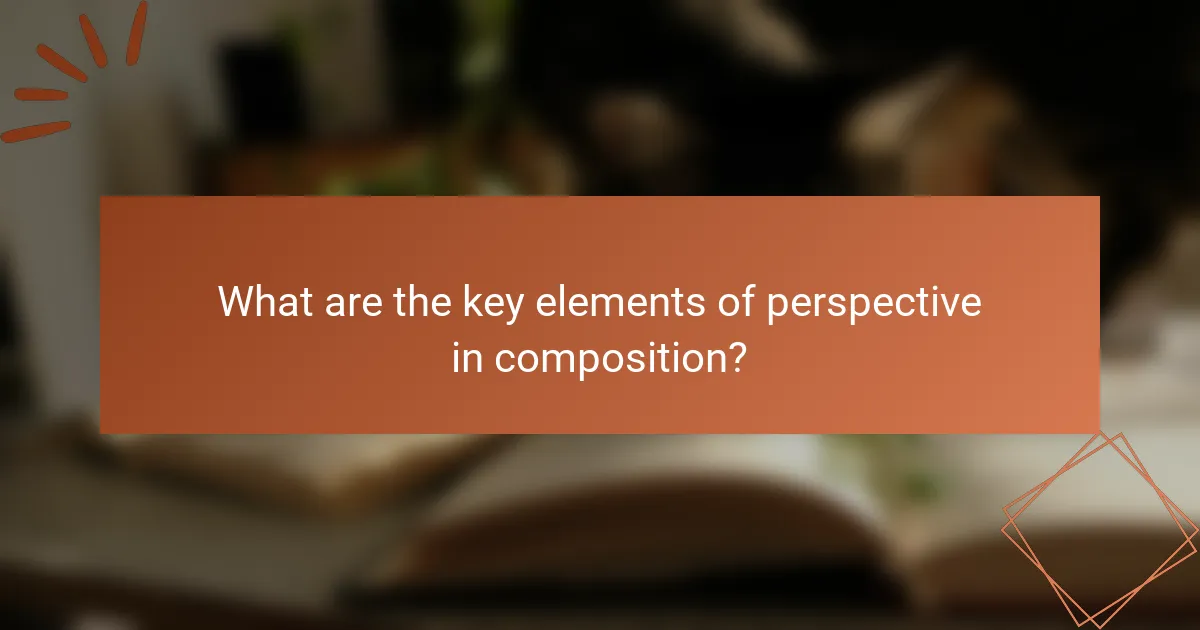
What are the key elements of perspective in composition?
The key elements of perspective in composition are depth, angle, and focal point. Depth creates a sense of three-dimensional space. It can be achieved through overlapping objects and varying sizes. Angle refers to the viewpoint from which the subject is observed. Different angles can evoke different emotions and interpretations. Focal point directs the viewer’s attention to a specific area. It is often emphasized through contrast, color, or placement. These elements work together to enhance visual storytelling and engage the viewer.
How do angles affect the perception of depth and space?
Angles significantly influence the perception of depth and space. They determine how objects relate to one another within a visual field. For instance, acute angles can create a sense of closeness, while obtuse angles may suggest distance. The viewer’s position relative to these angles alters their spatial interpretation. Studies show that varying angles can enhance dimensionality in two-dimensional art. Research by Palmer et al. (2007) demonstrates that angle manipulation impacts depth cues in visual perception. This indicates that angles are integral to how depth and space are experienced visually.
What are the common angles used in visual composition?
Common angles used in visual composition include eye level, high angle, low angle, and bird’s eye view. Eye level is the most neutral angle, providing a straightforward perspective. High angle shots look down on the subject, often making it appear smaller or weaker. Low angle shots are taken from below the subject, which can enhance its power or dominance. Bird’s eye view offers a unique perspective from directly above, creating a sense of overview. Each angle influences the viewer’s perception of the subject and the overall narrative.
How do different angles alter the viewer’s engagement with the subject?
Different angles significantly influence viewer engagement with a subject. High angles often create a sense of vulnerability or insignificance. Low angles tend to empower the subject, making it appear larger and more dominant. Eye-level angles provide a neutral perspective, fostering relatability. Extreme angles, such as Dutch tilts, can evoke tension or unease. Each angle alters emotional responses and perceptions of power dynamics. Research shows that angle choice affects cognitive processing and emotional engagement. A study by K. M. T. M. G. van der Laan et al. (2018) found that varying angles impacted viewer interpretation and emotional responses significantly.
What role does perspective play in creating balance and harmony?
Perspective is crucial in creating balance and harmony in composition. It influences how elements are arranged within a visual space. A well-defined perspective guides the viewer’s eye and creates a sense of depth. This depth enhances the overall aesthetic appeal of the composition. Different perspectives can evoke varying emotional responses. For example, a high-angle view may convey vulnerability, while a low-angle view can suggest power. The choice of perspective can harmonize conflicting elements by establishing relationships among them. This relationship fosters a cohesive visual narrative. Thus, perspective serves as a foundational tool in achieving balance and harmony in artistic compositions.
How can perspective be used to guide the viewer’s eye through a composition?
Perspective can be used to guide the viewer’s eye through a composition by creating depth and leading lines. By employing techniques such as linear perspective, artists can draw the viewer’s attention to focal points. Converging lines in a composition naturally lead the eye toward the horizon or a vanishing point. This technique helps establish a sense of space and dimension. Additionally, atmospheric perspective can enhance depth by using color and clarity to suggest distance. Objects that are closer appear sharper and more vibrant, while those further away appear muted. This contrast directs the viewer’s gaze across the scene. Overall, perspective serves as a powerful tool in composition to control visual flow and enhance engagement.
What techniques can be employed to achieve a balanced perspective?
To achieve a balanced perspective, one can employ techniques such as considering multiple viewpoints and utilizing critical thinking. Considering multiple viewpoints involves actively seeking out differing opinions and experiences. This technique broadens understanding and reduces bias. Critical thinking encourages the evaluation of evidence and arguments. It helps in discerning the validity of various perspectives. Additionally, using visual aids can illustrate contrasting angles effectively. Engaging in discussions with diverse groups fosters a richer dialogue. Practicing empathy allows for a deeper connection to others’ experiences. These techniques collectively contribute to a more nuanced and balanced perspective.
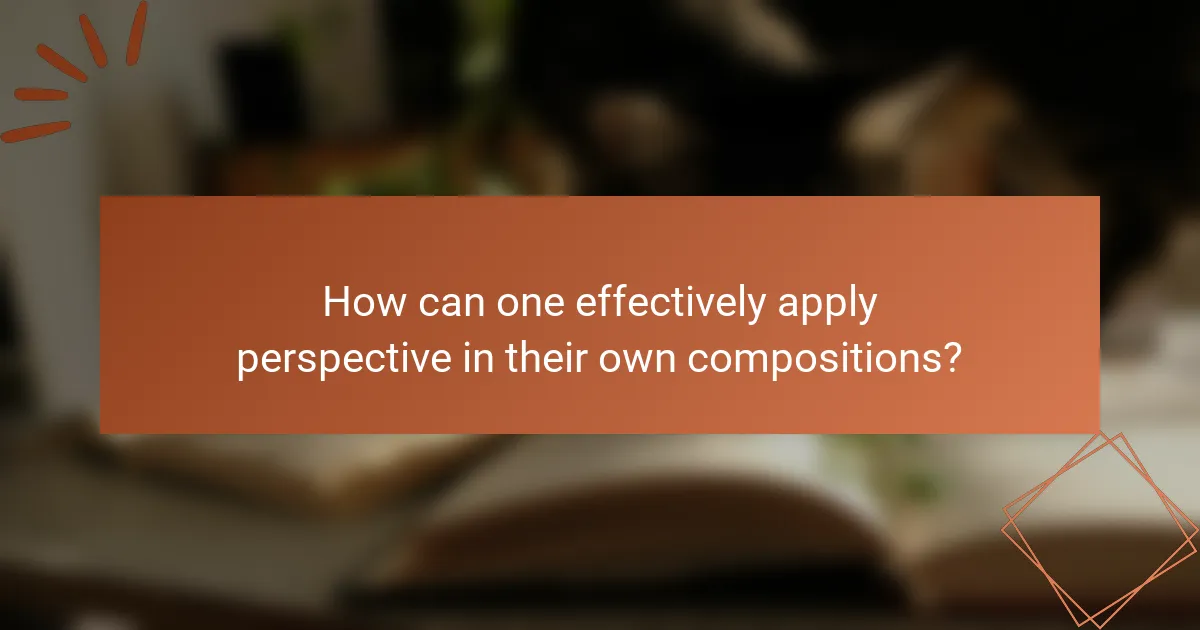
How can one effectively apply perspective in their own compositions?
To effectively apply perspective in compositions, one should understand the concept of viewpoint. Perspective shapes how the audience perceives the subject. Utilizing different angles can create depth and interest. For example, a low angle can make a subject appear powerful. Conversely, a high angle can suggest vulnerability. Incorporating foreground and background elements enhances spatial relationships. Techniques like overlapping and size variation also contribute to perspective. Artists often study works by masters to learn these techniques. This practice helps in developing a unique style while applying perspective effectively.
What practical tips can help improve perspective in composition?
To improve perspective in composition, utilize techniques such as varying angles and focal lengths. Experimenting with different viewpoints can create depth and interest. Incorporating leading lines guides the viewer’s eye through the composition. Using foreground elements enhances the sense of scale and dimension. Adjusting the horizon line can dramatically change the viewer’s perception. Employing atmospheric perspective helps convey depth through color and clarity variations. Lastly, practicing with different subjects can also enhance understanding of perspective. These methods are widely recognized in photography and art, validating their effectiveness in improving perspective.
How can experimenting with different perspectives enhance creativity?
Experimenting with different perspectives enhances creativity by introducing new viewpoints and ideas. This process allows individuals to break free from conventional thinking patterns. When people view a problem from various angles, they can identify unique solutions. Research shows that diverse perspectives stimulate cognitive flexibility. A study by Leung and Chiu (2010) found that exposure to different viewpoints increases creative problem-solving abilities. By challenging assumptions, individuals can generate innovative concepts. Overall, varying perspectives foster an environment conducive to creative exploration.
What common mistakes should be avoided when working with perspective?
Common mistakes to avoid when working with perspective include neglecting vanishing points. Failing to establish clear vanishing points can distort the viewer’s sense of depth. Another mistake is inconsistent horizon lines. This inconsistency can confuse the viewer and disrupt the composition’s balance. Overlooking scale is also a frequent error. Objects that lack proper scale can mislead the viewer about their relative size. Additionally, ignoring foreshortening can lead to unrealistic portrayals of objects. Proper foreshortening enhances the illusion of depth. Lastly, not practicing perspective drawing can hinder skill development. Regular practice is essential for mastering perspective techniques.
What are some examples of effective perspective use in renowned artworks?
Examples of effective perspective use in renowned artworks include “The Last Supper” by Leonardo da Vinci. This mural employs linear perspective to draw the viewer’s eye towards the vanishing point at [censured]’s head. “School of Athens” by Raphael showcases atmospheric perspective, creating depth through overlapping figures and diminishing size. “View of Toledo” by El Greco uses a dramatic bird’s-eye view to enhance the emotional impact of the cityscape. “The Arnolfini Portrait” by Jan van Eyck features a convex mirror that reflects the room, adding layers of perspective. Each artwork demonstrates mastery of perspective techniques to enhance composition and viewer engagement.
How have famous artists utilized perspective to convey their message?
Famous artists have utilized perspective to enhance their visual storytelling. Artists like Leonardo da Vinci employed linear perspective to create depth in works such as “The Last Supper.” This technique directs the viewer’s gaze to focal points, reinforcing the narrative. Similarly, Raphael used atmospheric perspective in “The School of Athens” to convey spatial relationships. This method softens distant objects, creating a sense of realism. In contrast, Cubist artists like Pablo Picasso broke traditional perspective to challenge perceptions of reality. This approach conveyed multiple viewpoints simultaneously, inviting deeper interpretation. Each artist’s use of perspective serves to communicate complex themes and emotions effectively.
What lessons can be learned from analyzing these examples?
Analyzing examples of perspective in composition reveals several key lessons. First, different angles can dramatically alter the viewer’s interpretation. For instance, a low angle can convey power, while a high angle may suggest vulnerability. Second, the use of perspective can enhance storytelling by guiding the viewer’s focus. Techniques like leading lines draw attention to specific elements within the composition. Third, understanding perspective aids in creating depth and dimension, making images more engaging. Finally, analyzing diverse examples fosters creativity, encouraging experimentation with various viewpoints. Each lesson underscores the importance of perspective in visual storytelling and composition.
What resources are available for mastering perspective in composition?
Books on perspective in composition include “Drawing on the Right Side of the Brain” by Betty Edwards. This book teaches fundamental principles of perspective drawing. Online courses, such as those offered by Skillshare and Coursera, provide structured learning on perspective techniques. Tutorials on platforms like YouTube cover practical exercises in perspective. Websites like the Virtual Instructor offer free resources and lessons on perspective. Additionally, art communities like DeviantArt provide forums for feedback and discussion on perspective. These resources collectively support mastering perspective in composition.
Which books or online courses provide valuable insights into perspective?
“Understanding Perspective” by David A. Carter offers valuable insights into perspective in art and design. This book covers various techniques for achieving depth and dimension. It provides practical exercises to enhance understanding.
“Perspective Made Easy” by Ernest R. Norling simplifies complex concepts of perspective. It is widely recommended for beginners and advanced artists alike.
The online course “The Complete Perspective Drawing Course” on Udemy teaches essential perspective skills. It includes video lectures and assignments for hands-on learning.
“Fundamentals of Perspective” on Skillshare is another useful online resource. It focuses on both one-point and two-point perspective techniques.
These resources collectively provide foundational knowledge and practical skills in perspective.
How can community feedback improve one’s understanding of perspective?
Community feedback enhances understanding of perspective by providing diverse viewpoints. Engaging with different opinions broadens one’s awareness of various interpretations. This interaction fosters critical thinking by challenging existing beliefs. Feedback can highlight blind spots that an individual may not recognize. For example, studies show that collaborative discussions lead to richer insights. Research indicates that exposure to contrasting perspectives can improve decision-making skills. Therefore, community feedback serves as a vital tool in deepening one’s comprehension of perspective.
The main entity of the article is ‘perspective’ in the context of composition. The article explores the significance of perspective in both visual and narrative compositions, detailing how different angles and viewpoints affect emotional engagement and interpretation. It discusses various types of perspectives, including first-person, second-person, and third-person, as well as the impact of angles on depth and viewer perception. Additionally, it highlights practical techniques for applying perspective effectively, common mistakes to avoid, and resources for mastering these concepts in artistic practices.
